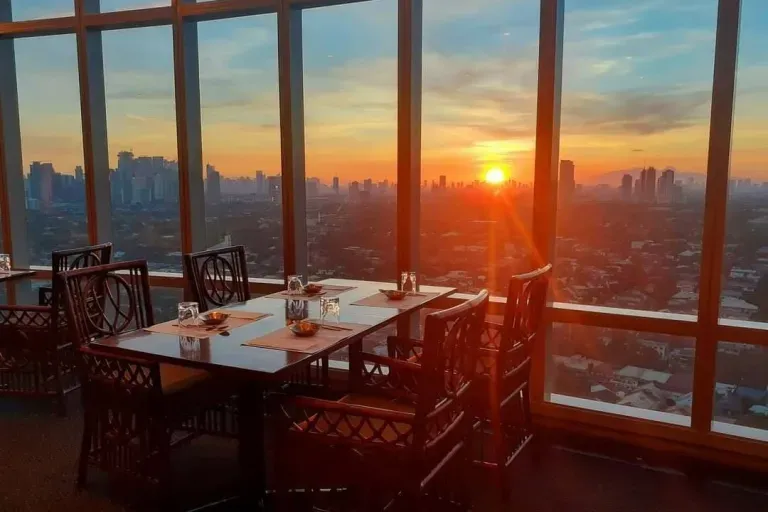Our favourite places to stay on this sleepy Cebu island.
Ever Dreamed of Eating in a Revolving Restaurant? Here’s Where You Can Do It in Manila

As fancy as they are, revolving restaurants aren’t exactly a new concept in highly developed places around the world. In Asia, you’ll find several of these innovative dining establishments all over countries or territories like the United Arab Emirates, China, India, Macao, Malaysia, and even Thailand. But a revolving restaurant in the Philippines? It may come as a surprise to some, but it exists, too!
On top of the already existing but highly overlooked Pasig Overlooking Restaurant, there’s also Seoul-Sky 100 Revolving Restaurant. Located in Bagumbayan, Quezon City, this rare revolving restaurant in the Philippines offers a 360-degree view of the Metro Manila skyline. Best of all, it’s easily accessible from key points in the National Capital Region.
Also read: Overlooking Restaurants and Cafés Near Manila? These Ones Aren’t in Antipolo
What to order in this revolving restaurant in the Philippines
Unlike the Pasig Revolving Restaurant, which caters to private events and guests, Seoul-Sky 100 welcomes casual dining of solo, couples, and small groups. They mainly serve affordable yet deliciously crafted Korean food for budget-friendly diners.

For Korean soup and stew, expect to pay as low as ₱380 for their beef rib and kimchi bowl. At ₱750 and ₱1,200, you can try their ginseng chicken soup and spicy sausage or ham stew with ramen, respectively. These are already good for couple or small group sharing. For rice meals, Seoul-Sky 100 offers bibimbap and fried rice for only ₱380, among others.
When trying out the restaurant’s side dishes, be sure to order their shrimp tempura, spicy stir-fried squid, and spicy stir-fried pork bulgogi with vegetables. Each serving is available for ₱450. They also serve Korean-style pancakes from just ₱350 and a variety of classic Korean noodles from ₱280.

And if you want a good ol’ samgyeopsal, they offer this as well. A 160-gram plate of standard pork belly is priced at ₱380 with a minimum of two orders. A 150-gram serving of Wagyu beef brisket is available for ₱550, while a 300-gram serving of marinated beef short rib is available for ₱930.
Also read: 10 Coffee Shops in Quezon City That You Have to Visit
Things to remember before visiting Seoul-Sky 100
Aside from Korean food, Seoul-Sky also serves hot and cold beverages. For this, try their mint mojito lemonade, passion fruit cooler, and their signature coffee. You can also order their Korean barbecue as part of different special set menus. The starting rate is ₱2,800 and each set is good for up to four people.

Before visiting the restaurant, be sure to reserve your seats in advance via their official Facebook page. There, you can also check out more of the dishes and drinks they serve, as well as read reviews from past customers. Seoul-Sky 100 is open daily from 11am to 8pm. If you’re lucky, you can even meet the owner himself as he regularly tends to visitors.
Seoul-Sky 100 Revolving Restaurant in the Philippines is on the 33rd Floor of MDC 100 along Eastwood Avenue. You can conveniently drive there via a private vehicle or Grab. When commuting, ride a jeepney that plies the E. Rodriguez Jr. area. Get off at Eastwood Avenue and you should be able to see the 33-storey MDC 100 building in the corner. Make your way to the topmost floor. As always, wear your face mask and face shield. Also, practise social distancing at all areas of the establishment.
All images credited to Seoul-Sky 100 Revolving Restaurant.
Published at
About Author
Joser Ferreras
Subscribe our Newsletter
Get our weekly tips and travel news!
Recommended Articles
10 Bantayan Island Resorts, Hotels, and Rentals for Your Tropical Escape 10 Best Banawe Restaurants for a Mouthwatering Food Trip in QC The promise of new flavours beckons from Banawe.
10 Best Mountain Cafes in the Philippines for Your Peak Coffee Experience Coffee date on the mountains, anyone?
10 Instagrammable Laguna Restaurants and Cafes You’ll Love Elevate your Insta-game at these Laguna spots.
10 Pristine Beaches in Batangas for a Relaxing Tropical Break All within arm’s reach of Manila!
Latest Articles
Guide to Palawan Delicacies: 9 Authentic Must-Eats and Pasalubong Taste your way to Palawan!
Canada Expands Visa-Free Travel to the Philippines: Here’s What You Need to Know Filipinos can now travel to Canada visa-free!
First American Pope Elected: Meet Pope Leo XIV Historic Vatican moment unfolds
Limasawa Island: Beaches, History, and Hidden Gems Where history and island life meet
Your Complete Travel Guide to Bonbon Beach: One of the World’s Best Beaches in 2025 Bonbon Beach in Romblon just made it to the world’s best beaches list!

